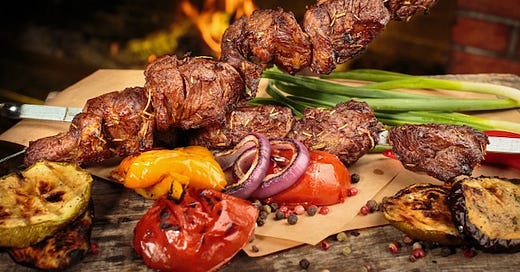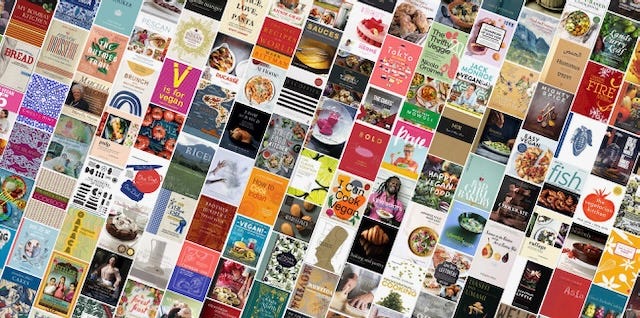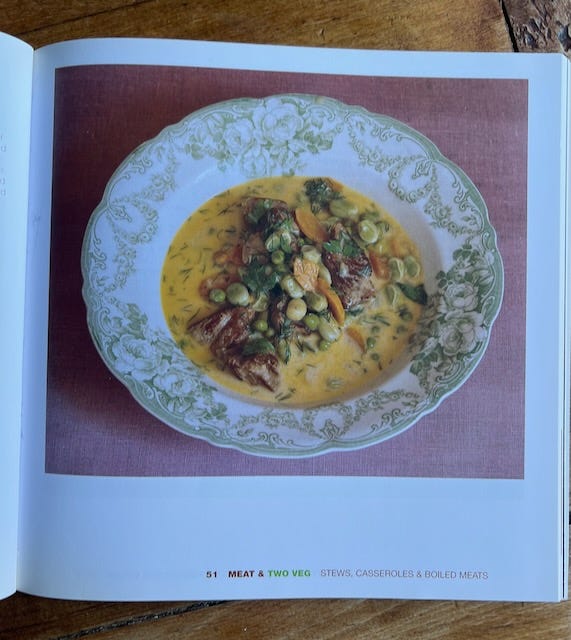The well-loved cookbook challenge #9
Which is all about lamb (+ a recipe to - hopefully - change your mind about this curiously unloved meat)
For the benefit of new subscribers who are unfamiliar with the well-loved cookbook challenge it’s about revisiting the bespattered books on our shelves, the ones we go back to time after time.
It stems from one of my most popular posts where everyone piled in to share the books they loved most and prompted the idea of cooking a recipe each month from a book that’s 10 years old or older.
It’s a regular free feature on my Substack but it you’d like my weekly food, travel and moneysaving wine tips as well as other exclusive content you can subscribe for as little as £5.
It seems appropriate to make lamb the theme of this month’s well loved cookbook challenge this month a) because it’s Easter and b) because It seems like quite a retro ingredient, accounting for a minuscule 1% of the meat we buy according to this piece I wrote for Club Oenologique back in 2020.
That probably won’t surprise you if you think about the space it occupies on the supermarket shelf compared to the amount they devote to beef, pork and chicken.
And there are no lamb cookbooks so far as I’m aware while there are plenty devoted to chicken, pork and beef - or at least steak.
It seems counter-intuitive when it’s not only one of the most sustainable meats but one of the most versatile.
It was certainly a meat we ate a lot when I was growing up. A Sunday roast eaten cold* (ugh) or as or a shepherd’s pie the next day then a lamb curry a day or two later on which I was even less keen. But I loved the roast.
* although lamb can work in a salad as you can see here
We also used to regularly have lamb chops though not Irish stew or Welsh cawl for which I have rather a soft spot. I admit it doesn’t sound that exciting.
But there’s surely no excuse these days for not buying into the many flavourful lamb dishes across Europe, North Africa and the middle east.
France, in particular is rich in rustic lamb dishes from lamb boulangère to navarin of lamb. There’s are several good dishes in Caroline Conran’s excellent Sud de France - The food and cooking of Languedoc including lamb sautéed with green and black olives which you can access through the special offer below.**
Lamb also rules in northern Spain - it’s impossible to visit a winery in Rioja without them offering you ridiculously moreish cutlets of milk fed lamb grilled over vine clippings
But the heart of lamb cookery is across the southern Mediterranean and into the middle east and central Asia. Morocco’s tagines, Greece’s moussaka, Turkey’s köfte - If you want inspiration just reach for your copy of Claudia Roden’s New Middle Eastern Food.
I haven’t tried Olia Hercules Azerbaijani rice and fruity lamb from her first book Mamushka even though I bookmarked it. You might also want to dip into Sabrina Ghayour’s first book Persiana (2014) for her kofta kebabs and lamb biryani (the latter is also available on the Guardian’s website)
Lamb grills magnificently whether it’s a whole butterflied leg of lamb, kebabs or spicy sausages like merguez. That’s partly because it has a great affinity with spices especially cumin, coriander and chilli.
In fact start thinking about the ingredients that go with lamb and where do you stop? Potatoes, turnips, beans, lentils and chickpeas (especially hummus). All the alliums - onions, leeks and garlic. Peas, spinach, asparagus and aubergines. In fact all the Mediterranean veg. Fruits like apricots, cherries, pomegranate and lemon. Dairy: think yoghurt, goats cheese and feta.
Herbs. Where do I start? Mint, rosemary, coriander, dill - just think of roast or grilled lamb with the classic salsa verde. Jamie has a good one or try my spring lamb stew with herbs and lemon from my book Meat and Two Veg (below).
Anchovies, capers and olives … all lamb lovers.
For other suggestions see Niki Segnit’s brilliant Flavour Thesaurus which should definitely be on your bookshelf but I think I’ve more than made my point.
If you’re not cooking with lamb this April you should be. (Yes I know it’s better later in the summer but it feels just right for spring.)
Do tell me your favourite lamb recipes - assuming you have favourite lamb recipes - or are you one of the 99% who doesn’t buy lamb?
And if you enjoyed this post it would be great if you would give it a ❤️
**You can find this recipe on ckbk, a site to access if you don’t want to overload your shelves with yet more cookery books though it admittedly doesn’t include many of the big name authors. But for older books - the ones we’re looking at in this series - it’s ideal.
Matthew Cockerill, who runs ckbk is offering ETDT paid subscribers a free 60 day trial then a reduced subscription of 25% off after that which brings an annual subscription down to £29.99. Caroline Conran’s lamb and olive dish is there for example. Or just click this link to dip into other books
Spring lamb stew with herbs and lemon
I know I say I’m against recipes for 4 but this was originally for my cookbook Meat and Two Veg, published in 2006. That said, I reckon two hungry eaters could demolish it between them, or you could have the leftovers the following night.
Serves 3-4
3 tbsp of light olive oil or sunflower oil
450g lean lamb (leg of lamb or lamb steaks), cut into medium-sized cubes
1 medium onion, peeled and roughly chopped
2 medium carrots, peeled and thinly sliced
Grated rind of 1/2 a lemon, preferably unwaxed
1 rounded tbsp plain flour
350ml chicken stock or stock made with 1/2 an organic stock cube
125g (podded weight) small fresh or frozen broad beans
75g fresh or frozen peas
1 heaped tbsp finely chopped fresh dill
1 heaped tbsp finely chopped fresh parsley
2 tbsp crème fraiche or double cream
Salt, freshly ground black pepper and lemon juice to season
Heat a frying pan over a high heat for 2-3 minutes, add 1 tbsp of the oil and fry the lamb quickly on all sides until lightly browned. Transfer to a casserole or saucepan. Turn the heat down, add the remaining oil, tip in the chopped onion and carrot and cook gently for about 6/7 minutes until beginning to soften. Add the lemon rind and flour, stir for a minute then add the stock and bring to the boil. Pour the stock and vegetables over the meat, cover and simmer over a low heat for about 45 minutes until the meat is just tender. Add the broad beans and peas, bring back to simmering point and cook for another 10 minutes or so until the vegetables are ready. Turn off the heat and stir in the dill, parsley and crème fraiche or cream. Season with salt, pepper and a good squeeze of lemon.
Serve with rice or buttered new potatoes.







There is a really amazing lamb recipe in Purple Citrus and Sweet Perfume by Silvena Row, v much a well loved cookbook in my house. You sauté about four or five bunches of spring onions, add lamb and stock, leave to simmer and that’s about it. Infinitely versatile. I try to make it each Spring even though no one else in my household really eats lamb
There is a book called 'Lamb' in the The Good Cook series published by Time Life in 1981. Like the other books in the series the first half is about techniques and method; the different cuts of lamb, how to prepare and cook them. Everything from flash dinner party style roasts to slow braises with the more economical cuts to using up leftovers. Then at the end there are lots of wide ranging recipes. Richard Olney is listed as the chief consultant and Jane Grigson and Alan Davidson as the UK editors. Easily obtainable second hand, a bit dated in looks and layout maybe but still such a useful book